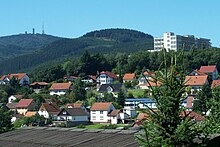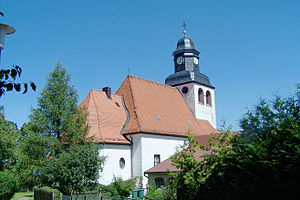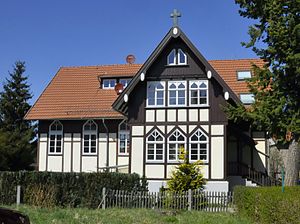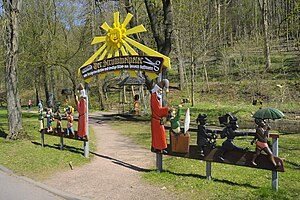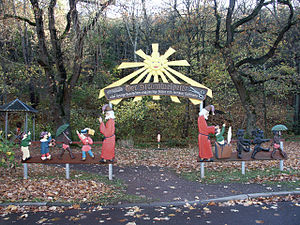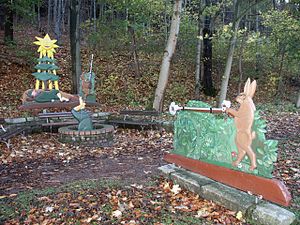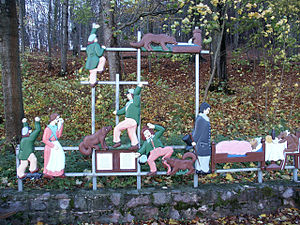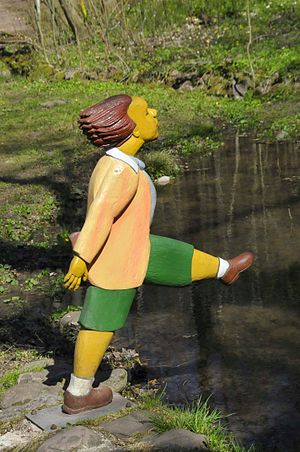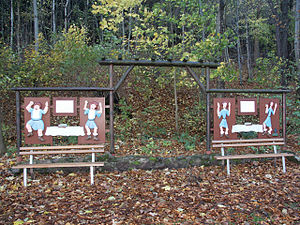Bad Tabarz
| coat of arms | Germany map | |
|---|---|---|
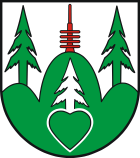
|
Coordinates: 50 ° 53 ' N , 10 ° 31' E |
|
| Basic data | ||
| State : | Thuringia | |
| County : | Gotha | |
| Height : | 394-916 m above sea level NHN | |
| Area : | 21.12 km 2 | |
| Residents: | 4136 (Dec. 31, 2019) | |
| Population density : | 196 inhabitants per km 2 | |
| Postal code : | 99891 | |
| Area code : | 036259 | |
| License plate : | GTH | |
| Community key : | 16 0 67 064 | |
| Address of the municipal administration: |
Theodor-Neubauer-Park 1 99891 Bad Tabarz |
|
| Website : | ||
| Mayor : | David Ortmann ( SPD ) | |
| Location of the municipality of Bad Tabarz in the district of Gotha | ||
Bad Tabarz (until March 9, 2017 Tabarz / Thür. Wald ) is a municipality and a climatic health resort in the district of Gotha in Thuringia . Tabarz has been a state-approved Kneipp spa since 2001, and a Kneipp spa since 2016.
geography
Bad Tabarz is located in the north-western Thuringian Forest about 4.2 kilometers from the Großer Inselsberg (916.5 m above sea level). The river Laucha is formed from several sources in the forest area between the forest towns of Kleiner Inselsberg and Tanzbuche . The Lauchagrund with its forests, caves and steep rocky areas is a popular hiking area on the southern edge of the municipality. The Laucha flows into the local situation Bad Tabarz in a long stretches secured by walls streambed north to the Hörsel counter and takes the next from the Cabarzer Mühlengrund Mühlbach in town center Bad Tabarz as a left tributary on.
In the south of the locality, the Datenberg (641.3 m above sea level) and the Zimmerberg (629.7 m above sea level), between which the Laucha flows, in the east the Finstere Tanne (519.9 m above sea level) and in the north of the Töpfersberg (415 m above sea level).
history
Archaeological finds in the vicinity of Torstein Castle confirm that people settled in the forests north of the Großer Inselsberg in prehistoric times . In the High Middle Ages at least three castle complexes were built near Tabarz, the Torstein Castle rises on a small rock spur of the Kleiner Wagenberg , about 80 m above the Lauchagrund. It is located about 3 km southwest of Tabarz. A medieval trade route, today's L 1024 , which climbs up to Grenzwiese - Kleiner Inselsberg , leads past Torstein Castle . The castles Stolzenburg and Leuchtenburg were only about 1 km away on this road . The arduous and often dangerous route over this trade route was an occasion and a basis for the small settlements of Tabarz ( Tannenfurte ) and Cabarz that developed at a ford .
Cabarz was first mentioned in 1397 and came into the possession of the Reinhardsbrunn monastery in 1400 . The majority of the residents worked as forest farmers and cleared the forest areas near the settlement for the creation of fields and pastures. Agriculture took place on hillsides in part on landscaped terraces that are still on Nonnenberg and on Tabarzer mountain below the Deysingslust can be seen. Mining and the charcoal burner trade were also represented.
After the dissolution of the Reinhardsbrunn Monastery in 1525, Tabarz and Cabarz belonged to the ruling office of Reinhardsbrunn , which from 1640 belonged to the Duchy of Saxe-Gotha , from 1672 to the Duchy of Saxe-Gotha-Altenburg and from 1826 to the Duchy of Saxe-Coburg and Gotha . The district of Klein Tabarz, mentioned for the first time in 1614, developed around the Untermühle and a ducal hunting lodge that was built there, which had already received brewing rights in 1562 . A major fire in Cabarz destroyed all but ten houses in the area. Other large fires occurred in Groß Tabarz in 1682 and 1821, in Cabarz in 1839.
From the beginning, the places were characterized by forestry and animal husbandry, as well as copper and silver mining. After 1730, mining declined noticeably, with the production and trading of drill , basketry and seeds taking its place . The once also existing branches of business of linen weaving and haulage came to a standstill with industrialization. After that, many residents only found a modest livelihood by working from home, before the beginning of the tourist traffic from 1875 and the settlement of their own industry after 1900 led to an upswing in the towns. Well-known vacationers were u. a. Theodor Fontane , Struwwelpeter author Heinrich Hoffmann , the Wagner opera singer Max Alvary and the major Berlin entrepreneur Carl Spindler , co-founder of the Tabarzer Kirchenbauverein from 1892.
In the district of Cabarz you come across the main building of a furrier near the church . This had specialized in the breeding of silver foxes and the processing of silver fox skins and still owned an animal enclosure on the outskirts for keeping cages.
In 1854 a 150 gram iron meteorite of the type Oktaedrite (IIICD) was found near Tabarz .
For a long time Cabarz was the most important place, as the first school and church were located there. All the inhabitants of the valley were parish and schooled here. The formation of today's Tabarz community took place in three steps. As early as 1866, a part of the settlement named after the neighboring Nonnenberg became part of the Cabarz community . The merger of Kleintabarz and Großtabarz to form Tabarz was completed in 1925. In 1946, Cabarz and Tabarz were combined to form today's Tabarz. Together with four other communities, the aforementioned districts formed the Tabarz community association in 1975.
Since 1941, during the Second World War, more than 100 prisoners of war and forced laborers had to do forced labor in the Adloffwerk , the Richard Engel company and the Ducal Forestry Office .
With effect from March 9, 2017, Tabarz was given the name “Bad” on the basis of the spa rating.
politics
Municipal council
The municipal council elected in the municipal council election on May 26, 2019 is composed as follows:
| list | % | Seats | G / V |
|---|---|---|---|
| FWG Tabarz | 100.0 | 16 | + 5 |
| SPD | 0.0 | 0 | - 5th |
coat of arms
Blazon : “In silver, a raised three-mountain topped with a silver-bordered green heart, from which a silver fir tree grows; On each side of the Dreiberg a growing green fir tree, in the middle a red transmitter mast with antenna and four cross bars. "
The coat of arms was designed in 2008 by the municipal heraldist Jörg Mantzsch from Magdeburg . The symbols mountain, fir, heart and tower were chosen from the heraldic image of the coat of arms, which were used in the new coat of arms, and were arranged and tinged in a heraldic manner according to the customs of heraldic art.
The relationships of the symbols mentioned to reality are as follows:
- Berg (Dreiberg) = island mountain
- Tannen = Tannfurt, the original place name of Tabarz meant Furtstelle in the fir forest
- The heart in green = Thuringia, the "green heart" of Germany
- Antenna / transmission tower = the Inselsberg transmitter, symbol of the region
These symbols are shown in an undivided coat of arms and were decided by the Tabarz municipal council in 2008.
The tinctures of the symbols and the shield are green and silver. Green forms the relationship to the natural surroundings of Tabarz, which is located in Thuringia, rich in forests. As a metal, silver (white) represents the counter tincture, which is necessary according to the basic rule of Tingi.
Partnerships
Kecel (Hungary), Gladenbach (Hesse) and Vrigne aux Bois (France) are partner municipalities of Tabarz.
Buildings and sights
Tabarzer Church
The Tabarzer Kirche St. Peter and Paul ( Lage → ) was built between 1912 and 1914 and shows a baroque style. At the same time P. Furtwängler & Hammer from Hanover supplied the organ. The rich interior was brought in with financial support from Carl Spindler . After the consecration of the church on May 17, 1914, the altar painting, which is a copy by a Dutch master, was attached after a donation. The church has a red, tiled hipped roof, as does the somewhat lower, semicircular, octagonal chancel in which the altar is located. The square tower is supported by a slate-covered tail dome with an attached lantern , also covered with a tail dome, with a mast with a tower ball and weather vane .
Another church is located in the Cabarz district .
"Struwwelpeter-Park Bad Tabarz"
From 1884 to 1894 Heinrich Hoffmann spent his summer in Tabarz. On this occasion, a "Struwwelpeter Park" was set up in Tabarz in 1994, in which carved Hoffmann figures and scenes have been set up. For each painted figure the corresponding story can be read. A memorial stone and a street name in Bad Tabarz also commemorate the children's book author. ( Location )
Other buildings and sights
Bad Tabarz has been a popular spa and tourist resort since 1875 and has sights and natural beauties (including the oven hole and the Aschenbergstein ).
- The village linden tree in Bad Tabarz can still be recognized as a dancing linden tree . ( Location )
- The local history museum can be found in the historical location of Cabarz close to the church (built around 1670) in the former village school. In 1899 the building was moved 4.25 m (reason: road widening).
- Several parks, including the Theodor-Neubauer-Park with the burial place of Theodor Neubauer , the Struwwelpeter Park in the Lauchagrund as well as the Steinpark : the structure of the Thuringian Mountains was depicted on a wall from 22 different types of rock.
- The Winkelhof spa park is located in the Cabarzer district on the southern outskirts, with a stage for concerts and theater events.
- In the Lauchagrund in the south of the village there is a promenade with around 40 Wilhelminian style villas. A park-like facility leads south to the Kneipp and herb garden and the tennis court. Large-format wooden sculptures based on the motifs of Struwwelpeter line the paths in the Lauchagrund.
- Minerals exhibition collection: In the center of Bad Tabarz, one of the largest private collections of this type in Thuringia is located in the former post office .
- A rhododendron garden and the ski jumping facility are to the west, on the edge of the forest of the Datenberg
- The TABBS spa and family pool is a leisure and recreation facility in Bad Tabarz and is considered a fun pool .
- The tourist information center is located near the center of Bad Tabarz in the KuKuNa (“Center for Art, Culture and Nature”).
- In 2015, a 21 m high observation tower with a panoramic view was opened on the Großer Inselsberg , in which there is another tourist information office for Bad Tabarz.
- There is a climbing forest at the foot of the data mountain .
Economy and Transport
The economy of Bad Tabarz is almost exclusively geared towards tourism. Tabarz has been a state-approved Kneipp spa since 2001. Kneipp spa since 2016 and the place has been called Bad since 2017. There are also a few smaller businesses. Bad Tabarz is the location of two clinics: the Inselsberg Clinic , an oncological rehabilitation clinic with 248 beds, and the Clinic am Rennsteig , a rehabilitation clinic specializing in orthopedics, cardiology and diabetology.
The place is on the federal highway 88 as well as on the state road 1024 leading over the Rennsteig to Brotterode . The junction Waltershausen of the federal highway 4 is about 6 km northeast. Bad Tabarz is the terminus of the Thuringian Forest Railway coming from Gotha . From the Bad Tabarz bus station you can get to the neighboring cities and towns of Brotterode, Bad Liebenstein , Ruhla , Bad Salzungen , Oberhof and Eisenach as well as the Rennsteig with the Großer Inselsberg. Bad Tabarz is on the German Toy Road .
The well-developed cycle path network leads in a northerly direction along the Laucha to Waltershausen and Gotha, in the east to Friedrichroda and Reinhardsbrunn and in a westerly direction to Winterstein, Seebach and the Großer Hörselberg .
Personalities
Organ builder Knauf
The story of the Knauf family from Großtabarz is remarkable . Johann Valentin knob, the son of a tailor's hall (carpenter) had, in away artisanal ability to organ building acquired and possessed since 1789 an organ building privilege. Since a large number of churches in the Duchy of Saxony-Coburg and Gotha had to be rebuilt or repaired during this time after the Seven Years' War , the Knauf family was well supplied with orders. In four generations the Knaufs in Großtabarz and later also in branches in Bleicherode and Gotha manufactured or repaired organs for over 100 churches.
Other personalities
- Heinrich Hoffmann (1809-1894), psychiatrist and writer ( Struwwelpeter ), spent his summer vacation in Tabarz from 1884-1894
- Theodor Lohmann (1831–1905), German administrative lawyer and social reformer, died in Tabarz
- Diederich Volkmann (1838–1903), classical philologist, rector of the Fürstenschule Schulpforta for 20 years , died in Tabarz
- Carl Spindler (1841–1902), Berlin entrepreneur, was instrumental in the development of tourism in Tabarz by founding a foreign committee
- Karl Korn (1865–1942), editor and publicist, died in Tabarz
- Julius Robert Hannig (1866–1931), sculptor, died in Tabarz
- Theodor Neubauer (1890–1945), member of the state and Reichstag for the KPD, built up a communist network of resistance against the Nazi regime by Tabarz, executed in 1945
- Alfons Anders (1928–1998), artist and philosopher, lived and worked from 1956 to 1988 in Tabarz
- Karl-Heinz Wedow (1935–2017), co-founder of the football journey through time, an association that specializes in memories of how football was then and now.
- Herbert Frauenberger (* 1952), TV chef and book author
literature
- J. Biemüller: Special menu for the summer resort Gross-Tabarz and surroundings. 1904.
- Heinrich Funke, W. Müller: From the history of the health resorts Tabarz-Cabarz in the Thuringian Forest. Verlag Benke Tabarz, no year.
- Herbert Kürth: Friedrichroda, Tabarz, Waltershausen. Tourist Wanderatlas by FA Brockhaus, Leipzig 1976.
- Carl Lerp: History of Cabarz and Tabarz with the Inselberg. Schmidt, Friedrichroda 1883. ( digitized version )
- Carl Lerp: The summer resort Tabarz (Grosstabarz and Kleintabarz) and the immediate vicinity. A guide for spa guests and tourists. Posted by Jac. Schmidt et al. Co, 1889.
- Horst H. Müller: The Thuringian Forest and peripheral areas. Tourist Verlag, Leipzig 1988, ISBN 3-350-00263-3 , pp. 686-691.
Web links
- Ortschronik (PDF; 2.2 MB)
- Bad Tabarz website
Individual evidence
- ^ Population of the municipalities from the Thuringian State Office for Statistics ( help on this ).
- ^ Thuringian Land Surveying Office: TK25 - sheet 5128 Ruhla , Erfurt 1992, ISBN 3-86140-048-0 .
- ↑ Tabarz. Meteoritical Bulletin, accessed June 13, 2020 .
- ↑ Thuringian Association of the Persecuted of the Nazi Regime - Association of Antifascists and Study Group of German Resistance 1933–1945 (Ed.): Local history guide to sites of resistance and persecution 1933–1945. Series: Heimatgeschichtliche Wegweiser, Volume 8 Thuringia. Erfurt 2003, ISBN 3-88864-343-0 , p. 101.
- ↑ FOCUS Online: Erfurt: Tabarz can now call itself "Bad Tabarz" . In: FOCUS Online . ( focus.de [accessed on March 14, 2017]).
- ^ Wieland Fischer: With firs and Inselsberg - Tabarz coat of arms now sealed. In: Gothaer Heimatbrief, No. 53/2008, p. 62.
- ↑ http://www.tabarz.de/erleben/sehenswerte/struwwelpeter-park/
- ↑ Christa von Schemm-Müller: A crazy thing. The old school of Cabarz. In: Hörselberg-Bote, No. 74/2008, pp. 50–52.
- ^ Fritz Reinboth: The organ builder family Knauf - a contribution to the organ history of Thuringia . Pape-Verlag, Berlin 2006, ISBN 3-921140-78-1 , p. 328 .



